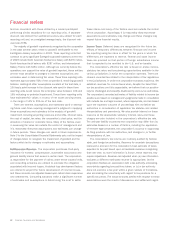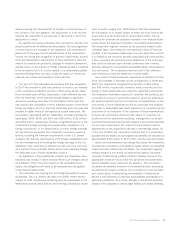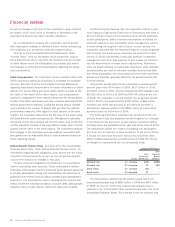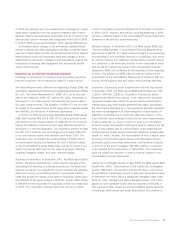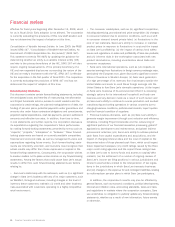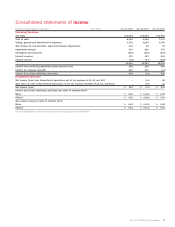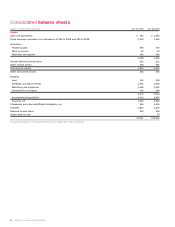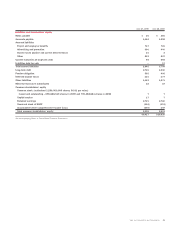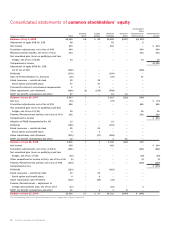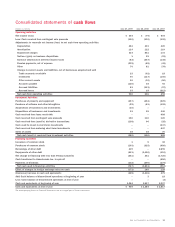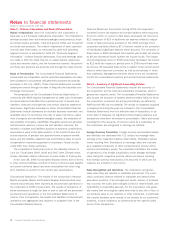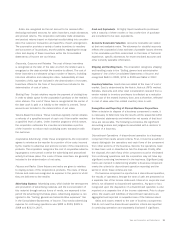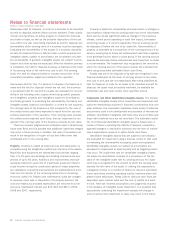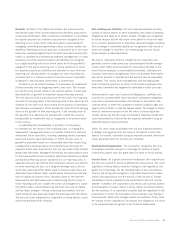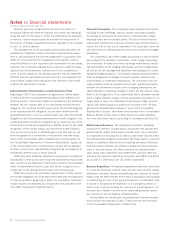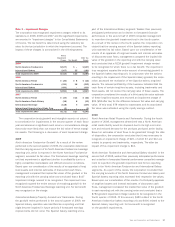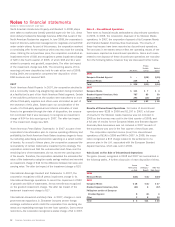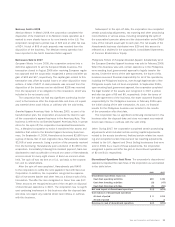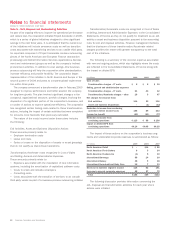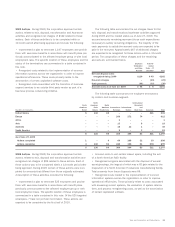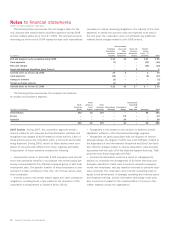Sara Lee 2009 Annual Report Download - page 54
Download and view the complete annual report
Please find page 54 of the 2009 Sara Lee annual report below. You can navigate through the pages in the report by either clicking on the pages listed below, or by using the keyword search tool below to find specific information within the annual report.Notes to financial statements
Dollars in millions except per share data
Note 1 – Nature of Operations and Basis of Presentation
Nature of Operations Sara Lee Corporation (the corporation or
Sara Lee) is a U.S.-based multinational corporation. The corporation’s
principal product lines are branded packaged meat products, fresh
and frozen bakery products, roast and ground coffee and household
and body care products. The relative importance of each operation
over the past three years, as measured by sales and operating
segment income, is presented in Note 22, “Business Segment
Information,” of these financial statements. Food and beverage sales
are made in both the retail channel, to supermarkets, warehouse
clubs and national chains, and the foodservice channel. Household
and body care products are primarily sold through the retail channel.
Basis of Presentation The Consolidated Financial Statements
include Sara Lee Corporation and its controlled subsidiaries and have
been prepared in accordance with generally accepted accounting
principles in the U.S. (GAAP). These financial statements consider
subsequent events through the date of filing with the Securities and
Exchange Commission.
The preparation of the Consolidated Financial Statements in
conformity with GAAP requires management to make use of estimates
and assumptions that affect the reported amount of assets and
liabilities, revenues and expenses and certain financial statement
disclosures. Significant estimates in these Consolidated Financial
Statements include allowances for doubtful accounts receivable, net
realizable value of inventories, the cost of sales incentives, useful
lives of property and identifiable intangible assets, the evaluation of
recoverability of property, identifiable intangible assets and goodwill,
self-insurance reserves, income tax and valuation reserves, the
valuation of assets and liabilities acquired in business combinations,
assumptions used in the determination of the funded status and
annual expense of pension and postretirement employee benefit
plans, and the volatility, expected lives and forfeiture rates for stock
compensation instruments granted to employees. Actual results
could differ from these estimates.
The corporation’s fiscal year ends on the Saturday closest to
June 30. Fiscal years 2009, 2008 and 2007 were 52-week years.
Unless otherwise stated, references to years relate to fiscal years.
In the June 28, 2008 Consolidated Balance Sheet, $30 of items
in other accrued liabilities and $12 of items in income taxes payable
and current deferred taxes have been reclassified into other long-
term liabilities to conform to the current year presentation.
Discontinued Operations
The results of the corporation’s Mexican
Meats, European Meats and Branded Apparel Americas/Asia busi-
nesses had previously been reported as discontinued operations in
the corporation’s 2008 annual report. The results of operations of
these businesses through the date of sale or spin off are presented
as discontinued operations in the Consolidated Statements of
Income. Prior to disposition, the assets and liabilities of discontinued
operations are aggregated and reported on separate lines of the
Consolidated Balance Sheets.
Financial Statement Corrections
During 2009, the corporation
corrected income tax expense and certain balance sheet accounts
for errors which, on a year to date basis, decreased net income by
$12 comprised of $19 of additional tax expense related to adjust-
ments of taxes previously provided on the 2008 earnings of the
corporation partially offset by $7 of income related to the correction
of individually insignificant balance sheet amounts. The correction of
these items in 2009 decreased third quarter year-to-date net income
by $8 and decreased fourth quarter net income by $4. The impact
of correcting these errors in 2008 would have decreased net income
by $12 while the impact on periods prior to 2008 would have been
de minimis. We evaluated these errors in relation to the current period,
which is when they were corrected, as well as the periods in which
they originated. Management believes these errors are immaterial
to both the consolidated quarterly and annual financial statements.
Note 2 – Summary of Significant Accounting Policies
The Consolidated Financial Statements include the accounts of
the corporation and its controlled subsidiary companies, which in
general are majority owned. The Consolidated Financial Statements
also include the accounts of variable interest entities (VIEs) for which
the corporation is deemed the primary beneficiary, as defined by
GAAP, but the VIEs are not material. The results of companies acquired
or disposed of during the year are included in the Consolidated
Financial Statements from the effective date of acquisition, or up
to the date of disposal. All significant intercompany balances and
transactions have been eliminated in consolidation. Gains and losses
resulting from the issuance of common stock by a subsidiary of
the corporation are recognized in earnings as realized.
Foreign Currency Translation Foreign currency denominated assets
and liabilities are translated into U.S. dollars at exchange rates
existing at the respective balance sheet dates. Translation adjust-
ments resulting from fluctuations in exchange rates are recorded
as a separate component of other comprehensive income within
common stockholders’ equity. The corporation translates the results
of operations of its foreign subsidiaries at the average exchange
rates during the respective periods. Gains and losses resulting
from foreign currency transactions, the amounts of which are not
material, are included in net income.
Sales Recognition and Incentives The corporation recognizes
sales when they are realized or realizable and earned. The corpo -
ration considers revenue realized or realizable and earned when
persuasive evidence of an arrangement exists, delivery of products
has occurred, the sales price charged is fixed or determinable, and
collectibility is reasonably assured. For the corporation, this gener-
ally means that we recognize sales when title to and risk of loss of
our products pass to our resellers or other customers. In particular,
title usually transfers upon receipt of our product at our customers’
locations, or upon shipment, as determined by the specific sales
terms of the transactions.
52 Sara Lee Corporation and Subsidiaries


